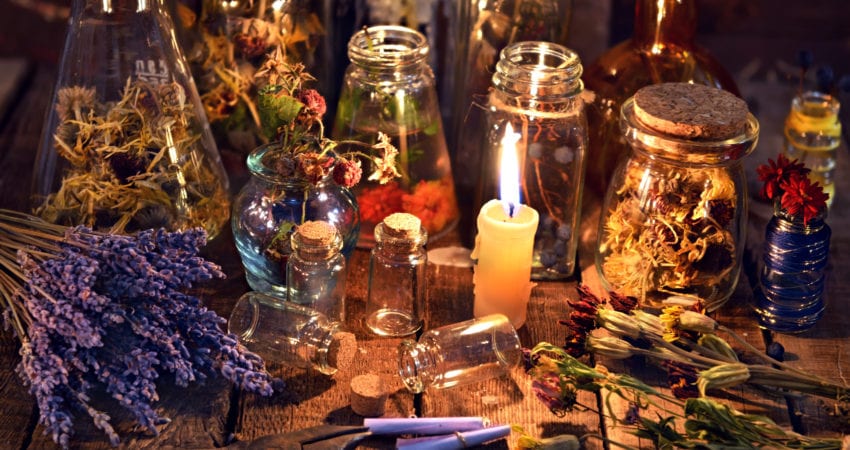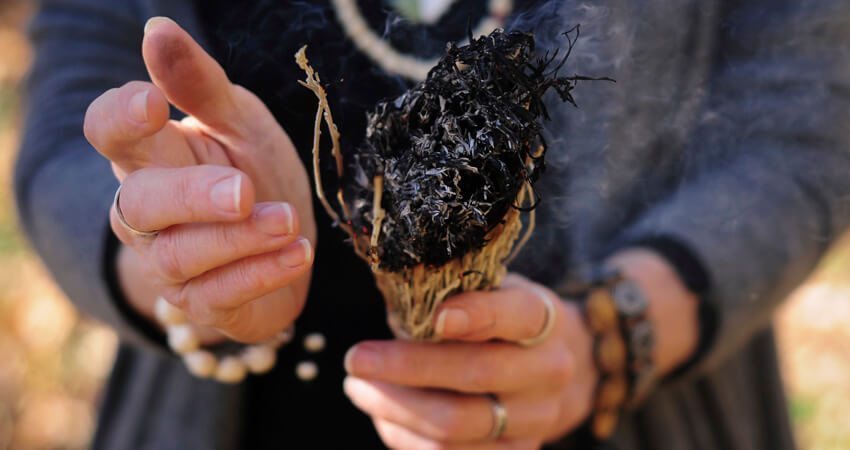
Spellwork: Do’s, Don’ts, and Building an Altar from Green Witch Robin Rose Bennett
Categories: General
Adapted from Healing Magic, 10th Anniversary Edition: A Green Witch Guidebook to Conscious Living by Robin Rose Bennett
Green Magic: Spells
Spells are focused on spelling out what you want or need, and are often quite effective. A spell can bring a magical vibration to your endeavor right from the beginning or, in some instances, a spell is done when you have exhausted all other possibilities. The four broad, basic steps of a spell are: Conceive it. Craft it. Communicate it. Release it. The fifth step underlies all the others: Know it’s possible, so you’ll open to receive it.
Spells are focused, and initiated within a ritual setting. When you do a spell, you are claiming your power as co-creative artist of your life. This is good practice for consciously collaborating with the Universe in creating your everyday life too.
One of the differences between a magical spell and a prayer is that in a spell, you are not actually asking; you are invoking and evoking. This is neither asking nor demanding; it is calling forth what you are seeking, and giving thanks for it as if you have already found it, as if whatever you want to happen has already happened. You are invoking what you want, and evoking the feeling that it has already manifested, by imagining it deeply and kinesthetically (in your body), and giving thanks for it.
Spells work best when done with the deepest gratitude for receiving. Give thanks for all you receive and have. Talk to God—Goddess—All-That-Is about what you want, with the full expectation of receiving exactly that, or something even greater that the Universe may have in mind for you. Spells are more about trust than control, more about honing your mind and opening your heart than about controlling your domain.
Building an Altar
Building an altar is not essential to doing a spell, but it is almost always done. An altar creates a focal point for your energy or the energy of the group. It also gives you something beautiful to place the directional candles on.
Basically, you need a lovely cloth, and a flat surface to spread it over. Once you have put candles for the four directions and the center on the special altar cloth, you have built an altar. Anything more is up to you. Sometimes additional symbols are placed on the altar to represent one or more of the elements. For example:
- East—knife, sword, feather, wing, magnifying lens or glass, pen
- South—matches, orange flowers, a yellow/orange/red crystal
- West—bowl, goblet, or chalice of water; mirror, seashells, salt, river rocks
- North—a stone, a bone, a crystal, a pentagram or a seven-or nine-pointed star, a plant, a small tree
Feel free to use any symbols that you choose for your altar items.
When casting a spell, you put your crafted spell and any other relevant sacred items on the altar. These are placed on the altar for some time, ranging from the length of the circle and spell-casting itself to months or even years, depending on the spell.
Generally, most spells will be left out, working on the altar, from three days to several moon cycles. When you cast a spell within a sacred circle, alone or with other people, it is being communicated. It continues to be communicated for whatever length of time your crafted item is left out on your altar, whether you are speaking spell words over it or not. Once you take your working sacred items off the altar, you begin to move into the fourth step—releasing the spell to the earth, to a living body of water, or to fire (which also includes air, as air both feeds the flames and receives the intentions and prayers carried in the smoke as the spell is released). I almost always give back the complete contents of the spell, but not usually the sacred items that were simply “assisting” by being part of the altar.
Many times people create altars that they don’t call altars; they call what they’re doing decorating. Family photo “shrines” are common forms of sacred altars in many homes. There are all sorts of altars. I have impromptu blessing altars all over the house. I build them spontaneously anywhere I go, inside and out. On the road, I use my jewelry or scarves—whatever I happen to have with me—or items from nature when I’m outside. Making altars creates beauty and harmony.
It’s good practice, too, for consciously engaging your magical, metaphorical mind, your eye for seeing meaning and beauty in the midst of the everyday world.
Use mostly natural items on your altar to evoke the sacred, including flowers, fruits, shells, stones, beeswax candles, feathers, favorite jewelry, herbs, crystals, and more. Create at least one sacred haven in your home. A home altar becomes a place where, if only for a moment, you can rest your eye, soothe your mind, and feel at peace.
Back to spells. In Women Who Run With the Wolves, Clarissa Pinkola Estés says, “Remember, whatever you are seeking is also seeking you.”
The clearer you are in calling to whomever you direct your invocations, the easier it is for what you are calling forth to find you. You have made yourself more receptive to it. Whatever you are dreaming of that has inspired you to craft your spell—whether it’s getting a sum of money you need, the wonderful lover you deserve, or helping to pass a resolution that saves the woods and wetlands in your township— you are creating a magnetic resonance in the present that magically attracts what you are calling forth from the future. You begin living in the future/present by inviting yourself to enjoy the feeling, now, that you hope to have more of in the future.
Metaphor and Symbol
Spell work requires symbolic thinking. It’s a combination of making mature decisions about what you want, and bringing childlike, artistic playfulness to the process of choosing how to attract it as you plan and craft your spell. In herbal magic, we look at the magical gifts and properties of plants and trees metaphorically, and connect those properties with ways they could be used symbolically in spells, rituals, and ceremonial magic.
Candles are another integral part of magical practices. Natural beeswax candles are preferable to petroleum-based candles if you can afford them. I have also recently begun to find soy and palm wax candles, and particularly like the palm candles. They are less expensive than beeswax, and burn well too. Be mindful to purchase palm candles that are sustainably harvested.
Candle Colors
Here are some symbolic associations, meanings, and magical uses of candles by color:
- Black—Trusting the unknown, traveling into the void, dreams and visions, seeking lost objects and/or people, rites of passage, letting go
- Blue—Creativity, writing, public speaking, art, intuition, healing, throat chakra
- Brown—Earth, soil, nding or selling homes, winning court cases, grounding and centering
- Gold—Abundance, solar energy, celebration, prosperity, psychic connectedness between the earth and the spirits above
- Gray—Friendship; entering into the otherworld
- Green—Abundance, prosperity, healing, physical connection with the earth; plants, love, generosity, gratitude, heart chakra
- Orange—Sex, vibrancy, fertility, virility, health; letting go of addictions; strengthening immunity; second chakra
- Pink—Self-love, universal love, joy, gratitude, heart chakra Purple—Spirit manifested on Earth; protection, leadership, spiritual strength; seeing through illusion and limitation; marking someone’s death/spirit journey; crown chakra
- Red—Love, sex, passion, romance, vital energy, womb wisdom, security, survival, root chakra
- Silver—Lunar energy, healing, celebration, moon wisdom, mystery, connectedness with the cosmos, cosmic origins
- Violet/Lavender—Peace, meditation, intuitive wisdom; first-eye and crown chakras
- White—Can be used for anything, including: gratitude, healing, innocence, marking death and/or birth
- Yellow—Con dence, optimism, personal power, wealth, intelligence, learning, third chakra (solar plexus)
There is no such thing as a “wrong” color to use. Trust your instincts.
You can use both physical and imagined symbols to represent what you are calling forth, and as a point of focus that helps evoke and direct your intent, concentration, feelings, and magical/creative energy. A spell incorporates conscious use of the imagination, and then adds the dimension of crafting a physical item to be a container for the creative life energy you are stirring with your spell.
More Do’s and Don’ts of Spells
Spells aimed at manifesting something are usually best done for yourself, rather than for someone else, especially when you are new at practicing magic. It’s often hard enough to know exactly what you really want at any given moment, much less what anyone else wants. Doing spells for other people can easily entangle you in situations that are not your own and, unless you are highly practiced, can bring complications that you surely don’t need. It’s also more transformative to recover magic for your own self.
Every act, magical or otherwise, brings consequences. Spell work can be very helpful in developing and fine-tuning your personal sense of honor, integrity, and ethics. Power is best used to serve, not rule. Magic practiced with an open hand and an open heart is the best kind of magic. Invoke exactly what you want, and then trust what you receive. You will always get what you need.
It doesn’t matter whether you ask the Universe, the Goddess, God, Spirit, Energy, Creator, All-That-Is, the Life Force, Divine Power, synchronicity, or the Tao. Just know that placing your absolute trust in it encourages the most wonderful magic to happen. Besides, “it” is wiser than you or I, and far more powerful—and will always get the final word every time, anyway!
Spells can be done alone, or by a group of people coming together to create a magical energy field. By calling the elements into a sacred circle and working within a supportive group, each individual’s personal magical focus can be further strengthened. Lastly, and perhaps most intriguingly for recovering Healing Magic in the everyday world, a group can gather with a united desire that is focused on social justice.
You could say that spells are a way of dramatizing your prayers, praises, intentions, desires, and commitments—making them beautiful, touching, and exciting. Spells can be quite serious when the occasion warrants it, and at other times they can be a lot of fun to dream up and enact. Sometimes, they can be both. Spells are rewarding whether or not they are “successful,” and unexpected results are sometimes even more valuable than the ones you’d envisioned.
Spells, like all authentic magic, always lead to self-revelation. If you are a willing student, your spells can teach you helpful things about the beliefs and feelings you hold about yourself, about other people, and about how the Universe works. Your beliefs are not necessarily true. The key is this: if you discover that your beliefs—true or false— support and encourage your growing freedom, joy, and creativity, let them be, at least for now. If you discover that your beliefs are limiting your full, joyous participation in life, you can be quite sure they are illusory. Be willing to let them change with the help of magic.
When you believe something, or believe in something, you have already separated yourself from it. This is different from what you know. You can only know what you are in intimate relationship with, something of which you are part. I don’t believe in magic, I know magic. We are magic.
Tags: Robin Rose Bennett


